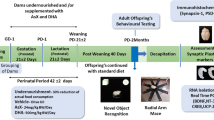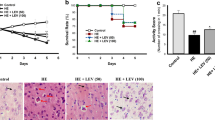Abstract
Oxidative stress is a critical contributing factor to age-related neurodegenerative disorders. Therefore, the inhibition of oxidative damage, responsible for chronic detrimental neurodegeneration, is an important strategy for neuroprotective therapy. Withania somnifera (WS) extract has been reported to have potent antioxidant and free radical quenching properties in various disease conditions. The present study evaluated the hypothesis that WS extract would reduce oxidative stress-associated neurodegeneration after intracerebroventricular injection of streptozotocin (ICV-STZ) in rats. To test this hypothesis, male Wistar rats were pretreated with WS extract at doses of 100, 200, and 300 mg/kg body weight once daily for 3 weeks. On day 22nd, the rats were infused bilaterally with ICV-STZ injection (3 mg/kg body weight) in normal saline while sham group received only saline. Two weeks after the lesioning, STZ-infused rats showed cognitive impairment in the Morris water maze test. The rats were sacrificed after 3 weeks of the lesioning for the estimation of the contents of lipid peroxidation, reduced glutathione, and activities of glutathione reductase, glutathione peroxidase, and catalase. Pretreatment with WS extract attenuated behavioral, biochemical, and histological alterations significantly in dose-dependent manner in the hippocampus and cerebral cortex of ICV-STZ-infused rats. These results suggest that WS affords a beneficial effect on cognitive deficit by ameliorating oxidative damage induced by streptozotocin in a model of cognitive impairment.








Similar content being viewed by others
References
Agrawal R, Tyagi E, Shukla R, Nath C (2009) A study of brain insulin receptors, AChE activity and oxidative stress in rat model of ICV STZ induced dementia. Neuropharmacology 56:779–787
Ahmad M, Saleem S, Ahmad AS, Ansari MA, Yousuf S, Hoda MN, Islam F (2005) Neuroprotective effects of Withania somnifera on 6-hydroxydopamine induced Parkinsonism in rats. Hum Exp Toxicol 24:137–147
Atlante A, Gagliardi S, Marra E, Calissano P (1998) Neuronal apoptosis in rats is accompanied by rapid impairment of cellular respiration and is prevented by scavengers of reactive oxygen species. Neurosci Lett 245:127–130
Bhattacharya A, Ghosal S, Bhattacharya SK (2001) Anti-oxidant effect of Withania somnifera glycowithanolides in chronic footshock stress-induced perturbations of oxidative free radical scavenging enzymes and lipid peroxidation in rat frontal cortex and striatum. J Ethnopharmacol 74:1–6
Bhattacharya SK, Satyan KS, Ghosal S (1997) Antioxidant activity of glycowithanolides from Withania somnifera. Indian J Exp Biol 35:236–239
Blokland A, Jolles J (1994) Behavioral and biochemical effects of an ICV injection of streptozotocin in old Lewis rats. Pharmacol Biochem Behav 47:833–837
Butterfield DA (2004) Proteomics: a new approach to investigate oxidative stress in Alzheimer's disease. Brain Res 1000:1–7
Carlberg I, Mannervik B (1975) Purification and characterization of the flavoenzyme glutathione reductase from rat liver. J Biol Chem 250:5475–5480
Claiborne A (1985) Catalase activity. In: Green Wald RA (ed) CRC hand book of methods for oxygen radical research. CRC Press, Boca Raton, pp 283–284
Davis L, Kuttan G (2001) Effect of Withania somnifera on DMBA induced carcinogenesis. J Ethnopharmacol 75:165–8
Ellman GL, Courtney KD, Andres V, Featherstone RM (1961) A new and rapid colorimetric determination of acetylcholinesterase activity. Biochem Pharmaco 7:88–95
Freeman BA, Crapo JD (1982) Biology of disease: free radicals and tissue injury. Lab Investig 47:412–426
Ghosh N, Ghosh R, Mandal SC (2011) Antioxidant protection: a promising therapeutic intervention in neurodegenerative disease. Free Radic Res 45:888–905
Grover A, Shandilya A, Punetha A, Bisaria VS, Sundar D (2010) Inhibition of the NEMO/IKKβ association complex formation, a novel mechanism associated with the NF-κB activation suppression by Withania somnifera's key metabolite Withaferin A. BMC Genomics 11(Suppl 4):S25
Halliwell B (2001) Role of free radicals in the neurodegenerative diseases: therapeutic implications for antioxidant treatment. Rev Drugs Aging 18:685–716
Halliwell B, Gutteridge JMC (1985) Oxygen radicals and nervous system. Rev Trends Neurosci 8:22–26
Hoyer S, Lannert H (1999) Inhibition of the neuronal insulin receptor causes Alzheimer-like disturbances in oxidative/energy brain metabolism and in behavior in adult rats. Ann N Y Acad Sci 893:301–303
Hoyer S, Nitsch R, Oesterreich K (1991) Predominant abnormality in cerebral glucose utilization in late-onset dementia of the Alzheimer type: a cross-sectional comparison against advanced late-onset and incipient early-onset cases. J Neural Transm Park Dis Dement Sect 31:1–14
Ishrat T, Khan MB, Hoda MN, Yousuf S, Ahmad M, Ansari MA, Ahmad AS, Islam F (2006) Coenzyme Q10 modulates cognitive impairment against intracerebroventricular injection of streptozotocin in rats. Behav Brain Res 171:9–16
Ishrat T, Hoda MN, Khan MB, Yousuf S, Ahmad M, Khan MM, Ahmad A, Islam F (2009) Amelioration of cognitive deficits and neurodegeneration by curcumin in rat model of sporadic dementia of Alzheimer's type (SDAT). Eur Neuropsychopharmacol 19:636–647
Javed H, Khan MM, Khan A, Vaibhav K, Khan A, Khuwaja G, Ahmad ME, Raza SS, Ashafaq M, Tabassum R, Siddiqui MS, El-Agnaf OM, Safhi MM, Islam F (2011) S-allyl cysteine attenuates oxidative stress associated cognitive impairment and neurodegeneration in mouse model of streptozotocin-induced experimental dementia of Alzheimer's type. Brain Res 389:133–142
Jin CH, Shin EJ, Park JB, Jang CG, Li Z, Kim MS (2009) Fustin flavonoid attenuates beta-amyloid (1–42)-induced learning impairment. J Neurosci Res 87:3658–3670
Jollow DJ, Mitchell JR, Zampaglione N, Gillette JR (1974) Bromobenzene-induced liver necrosis. Protective role of glutathione and evidence for 3,4-bromobenzene oxide as the hepatotoxic metabolite. Pharmacology 11:151–169
Khan MM, Ahmad A, Ishra T, Khuwaja G, Srivastava P, Khan MB, Raza SS, Javed H, Vaibhav K, Khan A, Islam F (2009) Rutin protects the neural damage induced by transient focal ischemia in rats. Brain Res 1292:123–135
Khan MB, Khan MM, Khan A, Ahmed ME, Ishrat T, Tabassum R, Vaibhav K, Ahmad A, Islam F (2012) Naringenin ameliorates Alzheimer's disease (AD)-type neurodegeneration with cognitive impairment (AD-TNDCI) caused by the intracerebroventricular-streptozotocin in rat model. Neurochem Int 61:1081–1093
Konar A, Shah N, Singh R, Saxena N, Kaul SC, Wadhwa R, Thakur MK (2011) Protective role of Ashwagandha leaf extract and its component withanone on scopolamine-induced changes in the brain and brain-derived cells. PLoS One 6:e27265
Lannert H, Hoyer S (1998) Intracerebroventricular administration of streptozotocin causes long-term diminutions in learning and memory abilities and in cerebral energy metabolism in adult rats. Behav Neurosci 112:1199–1208
Liu R, Liu IY, Bi X, Thompson RF, Doctrow SR, Malfroy B, Baudry M (2003) Reversal of age-related learning deficits and brain oxidative stress in mice with superoxide dismutase/catalase mimetics. Proc Natl Acad Sci U S A 100:8526–8531
Lowry OH, Rosenbrough NJ, Farr AL, Randall RJ (1951) Protein measurement with the Folin phenol reagent. J Biol Chem 193:265–275
Manjunath MJ, Muralidhara (2012) Withania somnifera prophylaxis abrogates Rotenone-induced oxidative impairments and mitochondrial dysfunctions in striatum and cerebellum of mice: relevance to Parkinson's disease. Cent Nerv Syst Agents Med Chem. PMID:23092410
Marques CA, Keil U, Bonert A, Steiner B, Haass C, Muller WE, Eckert A (2003) Neurotoxic mechanisms caused by the Alzheimer’s disease-linked Swedish amyloid precursor protein mutation: oxidative stress, caspases, and the JNK pathway. J Biol Chem 278:28294–28302
Meister A (1988) Glutathione metabolism and its selective modification. J Biol Che 263:1708–17205
Mishra LC, Singh BB, Dagenais S (2000) Scientific basis for the therapeutic uses of Withania somnifera (ashwagandha): a review. Alternat Med 5:334–346
Mohandas J, Marshall JJ, Duggin GG, Horvath JS, Tiller DJ (1984) Differential distribution of glutathione and glutathione-related enzymes in rabbit kidney. Possible implications in analgesic nephropathy. Biochem Pharmacol 33:1801–1807
Morris R (1984) Developments of a water-maze procedure for studying spatial learning in the rat. J Neurosci Methods 11:47–60
Naidu PS, Singh A, Kulkarni SK (2006) Effect of Withania somnifera root extract on reserpine-induced orofacial dyskinesia and cognitive dysfunction. Phytother Res 20:140–146
Paxinos G, Watson C (1986) The rat brain in stereotaxic coordinates, 2nd edn. Change to Academic Press, Sydney
Prickaerts J, Fahrig T, Blokland A (1999) Cognitive performance and biochemical markers in septum, hippocampus and striatum of rats after an i.c.v. injection of streptozotocin: a correlation analysis. Behav Brain Res 102:73–88
Racchi M, Mazzucchelli M, Porrello E, Lanni C, Govoni S (2004) Acetylcholinesterase inhibitors: novel activities of old molecules. Pharmacol Res 50:441–451
Sehgal N, Gupta A, Valli RK, Joshi SD, Mills JT, Hamel E, Khanna P, Jain SC, Thakur SS, Ravindranath V (2012) Withania somnifera reverses Alzheimer's disease pathology by enhancing low-density lipoprotein receptor-related protein in liver. Proc Natl Acad Sci U S A 109:3510–3515
Sharada AC, Solomon FE, Devi PU, Udupa N, Srinivasan KK (1996) Antitumor and radiosensitizing effects of withaferin A on mouse Ehrlich ascites carcinoma in vivo. Acta Oncol 35:95–100
Soman S, Korah PK, Jayanarayanan S, Mathew J, Paulose CS (2012) Oxidative stress induced NMDA receptor alteration leads to spatial memory deficits in temporal lobe epilepsy: ameliorative effects of Withania somnifera and Withanolide A. Neurochem Res 37:1915–1927
Sonkusare S, Srinivasan K, Kaul C, Ramarao P (2005) Effect of donepezil and lercanidipine on memory impairment induced by intracerebroventricular streptozotocin in rats. Life Sci 77:1–14
Sun Y (1990) Free radicals, antioxidant enzymes, and carcinogenesis. Free Radic Biol Med 8:583–599
Thompson PM, Vinters HV (2012) Pathologic lesions in neurodegenerative diseases. Prog Mol Biol Transl Sci 107:1–40
Tundo G, Ciaccio C, Sbardella D, Boraso M, Viviani B, Coletta M, Marini (2012) Somatostatin modulates insulin-degrading-enzyme metabolism: implications for the regulation of microglia activity in AD. PLoS One 7:e34376
Utley HG, Bernheim F, Hockstein P (1967) Effect of sulfhydryl reagent on peroxidation in microsome. Arch Biochem Biophys 260:521–531
Zhang H, Liu Y, Lao M, Ma Z, Yi X (2011) Puerarin protects Alzheimer's disease neuronal cybrids from oxidant-stress induced apoptosis by inhibiting pro-death signaling pathways. Exp Gerontol 46:30–37
Zhu X, Lee HG, Casadesus G, Avila J, Drew K, Perry G, Smith MA (2005) Oxidative imbalance in Alzheimer's disease. Mo Neurobiol 31:205–217
Acknowledgments
The authors thank the Department of Ayurveda, Yoga and Naturopathy, Unani, Siddha, and Homoeopathy (AYUSH), Ministry of Health and Family Welfare, Government of India, New Delhi, for the financial assistance. The technical assistance of Dharamvir Singh and Abdul Fitr are greatly acknowledged. We greatly acknowledge Dr. Amrish Kumar Tiwari (M.V.Sc. Pathology), Jamia Hamdard, India for the histological interpretation for this manuscript.
Conflict of interest
The authors have no conflict of interest.
Author information
Authors and Affiliations
Corresponding author
Additional information
Handling Editor: Pavel Dráber
Fund for the Improvement of Science and Technology was sponsored by DST and Special Assistance Programme was sponsored by UGC.
Rights and permissions
About this article
Cite this article
Ahmed, M.E., Javed, H., Khan, M.M. et al. Attenuation of oxidative damage-associated cognitive decline by Withania somnifera in rat model of streptozotocin-induced cognitive impairment. Protoplasma 250, 1067–1078 (2013). https://doi.org/10.1007/s00709-013-0482-2
Received:
Accepted:
Published:
Issue Date:
DOI: https://doi.org/10.1007/s00709-013-0482-2




